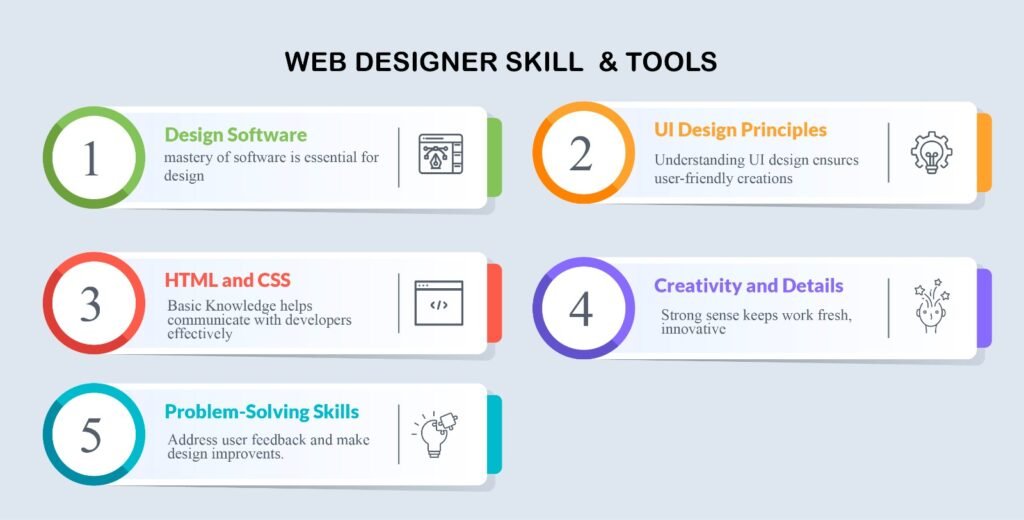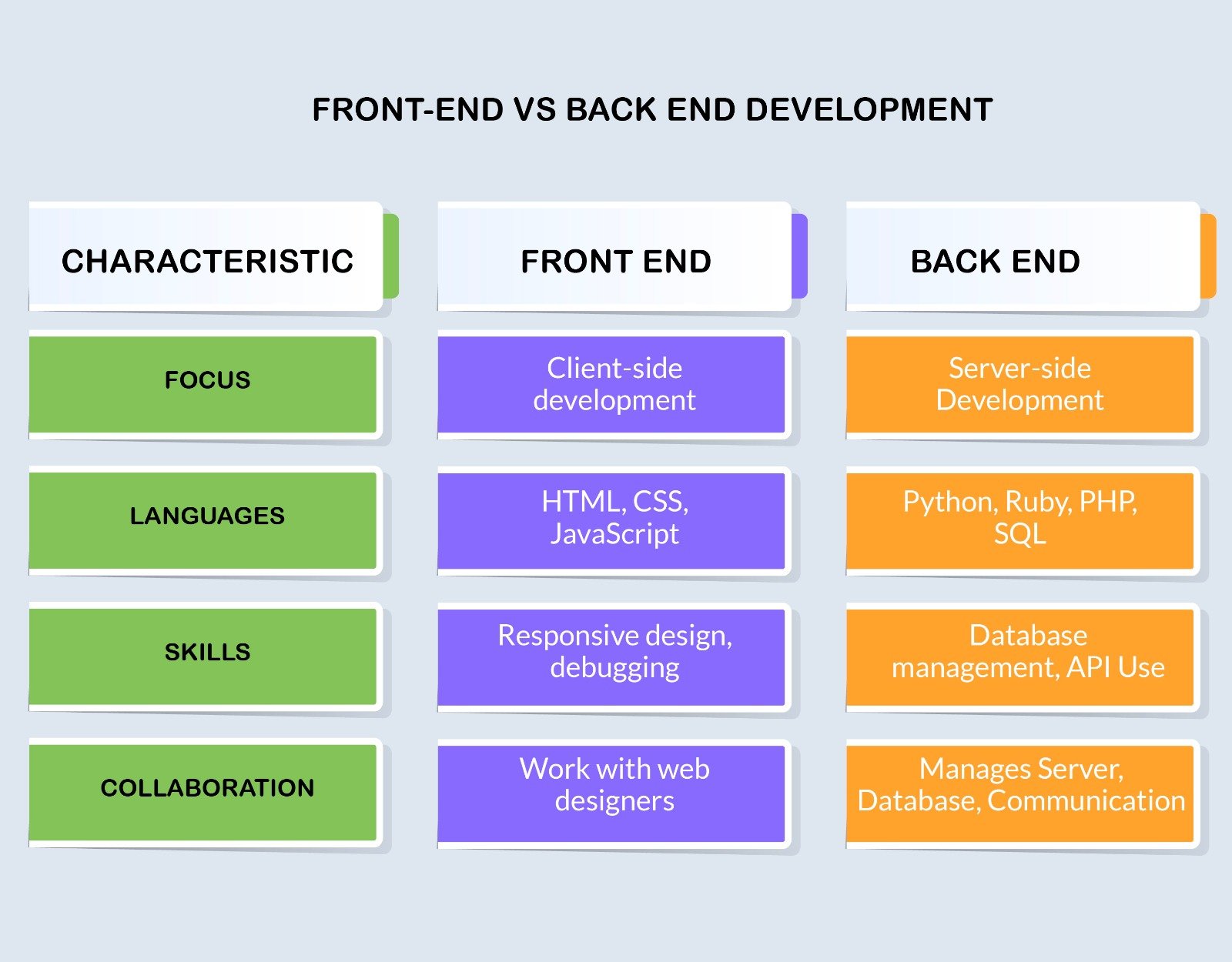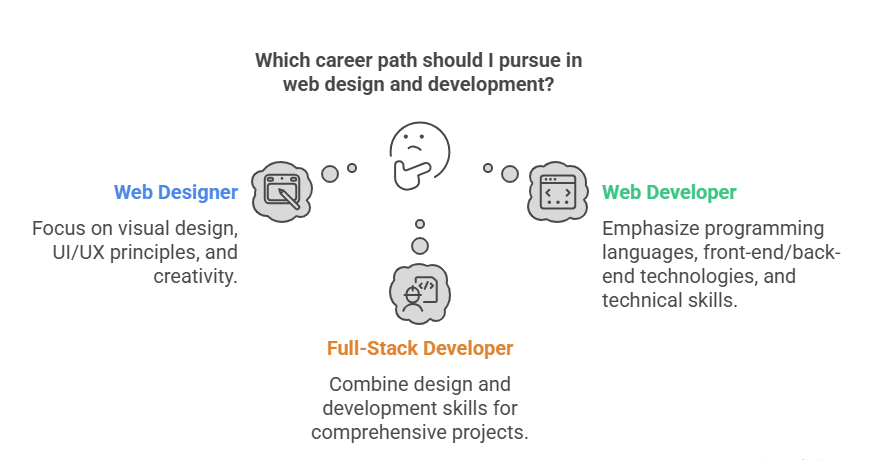The demand for professionals skilled in web design and development continues to grow. Although often used interchangeably, web design and development encompass distinct roles and responsibilities, each contributing uniquely to creating and maintaining websites. Understanding the difference between web design and web development is crucial for anyone aspiring to enter the field or collaborate with these professionals on digital projects. This article delves into the primary differences, roles, and career paths associated with web design and development, offering a comprehensive guide for enthusiasts and professionals.

What is Web Design?
Understanding Web Designer Responsibilities
Web designers focus on the aesthetic and usability aspects of a website. They are primarily concerned with how a site looks and feels to the user. A web designer’s responsibilities include creating layouts, choosing colour schemes, and selecting typography to ensure the website’s visual design is appealing and functional. Many web designers also incorporate graphic design elements to enhance the visual appeal of web pages. Their work often involves collaborating with UX designers to optimize the user experience, ensuring visitors can navigate the site intuitively and efficiently, which is crucial for retaining and engaging users.
Furthermore, web designers play a pivotal role in establishing the structure of a website. They use design software to craft prototypes and wireframes as blueprints for the final product. By focusing on visual design, web designers ensure that the website aligns with the brand’s identity and goals. Their artistic skill set and keen understanding of user interaction enable them to create engaging and seamless digital experiences. Additionally, by frequently liaising with web developers, they ensure that the design is technically feasible and can be executed effectively during development.
Tools and Skills in Web Design
Web designers require diverse skills and tools to excel in their field. Mastery of design software such as Adobe Photoshop, Illustrator, and Sketch is essential for creating visually stunning designs. Equally important is an understanding of UI design principles, which helps web designers ensure that their creations are attractive and user-friendly. A proficient web designer should also have a basic knowledge of HTML and CSS, allowing them to communicate effectively with developers and understand their designs’ technical constraints and possibilities.
In addition to technical skills, successful web designers possess a strong sense of creativity and an eye for detail. They stay updated with the latest design trends and emerging technologies to keep their work fresh and innovative. Furthermore, problem-solving skills are crucial, as web designers must often address user feedback and make iterative design improvements. By combining these skills, web designers can create compelling digital experiences that captivate and retain audiences, ultimately contributing to the success of a website.
The Role of UI/UX Designers in Web Design
UI and UX designers play a crucial role in web design by focusing on the user’s interaction with a website. A UI designer ensures the website’s interface is visually coherent and intuitive, facilitating an enjoyable user experience. This involves designing buttons, navigation menus, and other interactive elements that guide users through the site. On the other hand, UX designers conduct research and testing to understand user behaviours and preferences, allowing them to create a seamless journey from one page to another.
The collaboration between UI and UX designers is vital for crafting a cohesive web design strategy. Together, they work towards minimizing user frustration and enhancing overall satisfaction. By aligning their efforts, they ensure that the visual elements complement the functionality, resulting in a balanced and effective website. This synergy improves the user experience and contributes to achieving the website’s objectives, such as increasing conversions or enhancing brand loyalty. Their combined expertise in visual design and user psychology is indispensable in the ever-evolving landscape of web design.

What is Web Development?
The Role of a Web Developer
Web developers are responsible for bringing a web designer’s vision to life through code. They are tasked with building and maintaining the structure of a website, ensuring it is functional and interactive. A web developer’s role encompasses both front-end and back-end development work. Front-end developers focus on the client side, ensuring the website looks good and functions correctly in the browser. They work closely with web designers to implement the visual design using HTML, CSS, and JavaScript.
On the other hand, back-end developers concentrate on the server side, where they build and maintain the technology that powers the website. This involves working with databases, server logic, and application programming interfaces (APIs) to ensure the website operates smoothly. Web developers often collaborate with web designers, ensuring the development work aligns with the design specifications. Their technical expertise and problem-solving abilities are crucial for creating a robust and efficient website that meets user and client expectations.
Front-end Development vs Back-end Development
The distinction between front-end and back-end development is essential in understanding the comprehensive process of website development. Front-end development, often referred to as client-side development, involves the creation of everything the user interacts with directly. Front-end developers use languages like HTML, CSS, and JavaScript to build the visual components of a website, ensuring that the design is responsive and works across different devices and browsers.
Conversely, back-end development, or server-side development, involves managing the behind-the-scenes functionality of a website. Back-end developers use server technologies, databases, and APIs to process and store data. They ensure that the server, application, and database communicate effectively, allowing users to log in, make transactions, or retrieve data. Both front-end and back-end developers must work in tandem to create a seamless and functional website, highlighting the importance of collaboration in the web development process.
Essential Skills for Web Developers
Professionals need a robust skill set encompassing technical knowledge and problem-solving abilities to succeed in web development. Front-end developers must be proficient in HTML, CSS, and JavaScript, as these are the foundational languages for creating interactive web pages. A good understanding of responsive design principles is also crucial, as it ensures that websites function well on various devices, including smartphones and tablets.
Back-end developers require expertise in server-side languages such as Python, Ruby, or PHP and database management skills using SQL or NoSQL databases. Additionally, familiarity with version control systems, like Git, is essential for collaborative development work. Beyond technical proficiency, web developers must possess strong analytical skills to debug and optimize code effectively. As web development technologies and best practices constantly evolve, continuous learning and adaptability are key. By mastering these skills, web developers can build functional websites that meet modern standards and user expectations.

Understanding the Difference Between Web Design vs Web Development
Key Differences in Roles
The distinction between a web designer and a web developer lies primarily in their focus and responsibilities within the website creation process. Web designers are primarily concerned with a website’s aesthetics and user experience. They focus on visual elements, ensuring the website’s look aligns with the brand’s identity and appeals to the target audience. Their work involves creating layouts, selecting colour schemes, and designing interactive elements to enhance the user’s journey.
In contrast, web developers are responsible for the technical implementation of a website. They focus on making the design functional and ensuring the site operates smoothly and efficiently. While web designers craft the visual blueprint, web developers work on the underlying code that brings the design to life. This division of labour highlights the complementary nature of design and development, as both are essential for creating a successful website that is both visually appealing and technically sound. Understanding these key differences is crucial for anyone looking to enter the field or collaborate effectively with these professionals.
Design and Development: How They Complement Each Other
Web design and development are interdependent disciplines that must work harmoniously to create an effective website. While web designers focus on crafting an aesthetically pleasing and user-friendly interface, web developers ensure the design is technically feasible and functions as intended. This collaborative relationship is vital for seamlessly integrating visual elements and functionality, resulting in a cohesive and engaging user experience.
The synergy between design and development is evident in the iterative process of building a website. Designers and developers must communicate effectively to address technical constraints while maintaining the design’s integrity. By working together, they can identify and resolve potential issues early, ensuring that the final product meets aesthetic and functional requirements. This collaboration enhances the website’s overall quality and accelerates the development timeline, ultimately leading to a more efficient and successful project outcome.
Choosing Between a Web Designer or Web Developer
Deciding whether to hire a web designer or web developer depends on the specific needs of a project. Engaging a skilled web designer is essential if the primary goal is to create a visually captivating and user-friendly interface. Their visual design and user experience expertise can help craft a site that resonates with the target audience and aligns with the brand’s identity. A web developer’s skills are indispensable for projects requiring complex functionality or technical integration.
However, many projects benefit from the combined expertise of web designers and web developers. By leveraging the strengths of each, projects can achieve a balance between aesthetics and functionality. For individuals looking to enter the field, understanding the distinct roles and responsibilities can guide them in choosing a career path that aligns with their interests and skill set. Ultimately, the choice between a web designer or web developer should be dictated by the project’s objectives and the specific expertise required to achieve them.

The Role of a Web Designer vs Web Developer
How Web Designers Enhance User Experience
Web designers play a pivotal role in enhancing user experience by focusing on a website’s visual and interactive aspects. They strive to create intuitive and aesthetically pleasing designs that seamlessly guide users through the site’s content. By employing principles of graphic design and UI design, web designers ensure that the website is visually appealing and easy to navigate, providing a positive and engaging user experience.
Moreover, web designers collaborate with UX designers to conduct user research and testing, gathering insights into user behaviour and preferences. This data-driven approach allows them to make informed design decisions that enhance usability and satisfaction. By prioritizing the needs and expectations of users, web designers create digital experiences that are both enjoyable and effective in achieving the website’s objectives, such as increasing engagement and conversion rates. Their work is crucial in establishing a strong connection between the brand and its audience, ultimately contributing to the website’s success.
How Web Developers Build Functional Websites
Web developers are instrumental in transforming a web designer’s vision into a functional website. They focus on the technical aspects of development, ensuring the site operates smoothly and efficiently. By writing clean and efficient code, web developers bring the visual design to life, enabling dynamic features and interactions that enhance user engagement. Their front-end and back-end development expertise is crucial for building a robust and scalable website.
In addition to coding, web developers are responsible for optimizing website performance and ensuring compatibility across different devices and browsers. They conduct thorough testing and debugging to identify and resolve issues, providing a seamless user experience. Web developers also play a key role in implementing security measures and maintaining the website’s integrity over time. Their technical skills and problem-solving abilities are essential for creating a website that meets modern standards and user expectations, ultimately contributing to its success and longevity.

How to Become a Web Designer or Developer
Educational Paths for Aspiring Web Designers
Pursuing a formal education in graphic design, visual design, or digital media can provide a strong foundation for those aspiring to become a web designer. Many web designers also benefit from specialized courses in web design, which cover essential topics like UI design, UX principles, and design software proficiency. Online platforms and boot camps offer flexible learning options, allowing individuals to acquire hands-on experience and build a portfolio showcasing their design skills.
In addition to formal education, aspiring web designers should keenly understand current design trends and emerging technologies. Developing a strong aesthetic sense and honing creativity are crucial for crafting compelling and innovative designs. Building a diverse portfolio demonstrating various design styles and projects can significantly enhance job prospects. Networking with industry professionals and seeking mentorship opportunities can provide valuable insights and guidance, helping aspiring web designers navigate their career paths successfully.
Pathways to Become a Web Developer
Becoming a web developer typically involves gaining proficiency in programming languages and web technologies. Formal computer science or software engineering education provides a comprehensive understanding of development principles and practices. However, many successful web developers are self-taught, utilizing online resources, coding boot camps, and tutorials to acquire the necessary skills. Hands-on experience through personal projects or internships is invaluable for building a strong portfolio that showcases technical expertise.
Web developers should focus on mastering both front-end and back-end technologies and understanding the intricacies of responsive design and user interaction. Staying updated with industry trends and advancements is crucial for maintaining a competitive edge. Building a network within the tech community can provide support and open doors to job opportunities. Aspiring web developers can build a successful career in this dynamic and ever-evolving field by continuously learning and adapting to new technologies.
Building a Career in Web Design and Development
A web design and development career offers diverse opportunities, with pathways that can lead to specialization or a broad skill set encompassing both disciplines. For individuals interested in web design, enhancing creativity and visual communication skills can lead to roles such as UI designer or UX designer. Those inclined towards technical challenges may find fulfilment in web development, with opportunities to specialize as a front-end developer, back-end developer, or full-stack developer.
Success in this field requires a commitment to continuous learning and professional growth. A strong portfolio highlighting various projects and skills is essential for attracting potential employers and clients. Networking and staying engaged with industry communities can provide valuable insights and opportunities for collaboration. Ultimately, a web design and development career is both fulfilling and dynamic, offering the chance to work on innovative projects and contribute to the ever-evolving digital landscape.

Frequently Asked Questions (FAQs)
Alright, let’s break it down! Web design is all about the look and feel of a website. It’s like being an architect for a digital house, focusing on aesthetics, layout, and user experience. On the other hand, web development is the construction team that builds the house. They take the designs and turn them into a functioning site using code. Web design vs. web development is essentially creativity vs. functionality.
Nope, they’re different roles with different skill sets! A web designer works on the visual design of a site. They use tools like Photoshop or Sketch to create the layout. A web developer, whether a front-end developer or back-end developer, uses programming languages to bring those designs to life. It’s like the difference between an artist and an engineer.
You can wear both hats! Some choose to specialize in web design and development, becoming a web designer and developer. This means they have the skills to create stunning designs and the technical know-how to build them. It’s a bit like being a one-person band in the world of website design.
A front-end developer works on the part of the website that users interact with. They use languages like HTML, CSS, and JavaScript to ensure everything looks good and works smoothly. It’s their job to implement the UI design created by the web designers into a functional website.
Good question! A back-end developer is like the wizard behind the curtain. They handle the server side, managing databases and ensuring the site’s functionality. They make sure that everything works seamlessly from behind the scenes, enabling the front-end web to perform like a charm.




